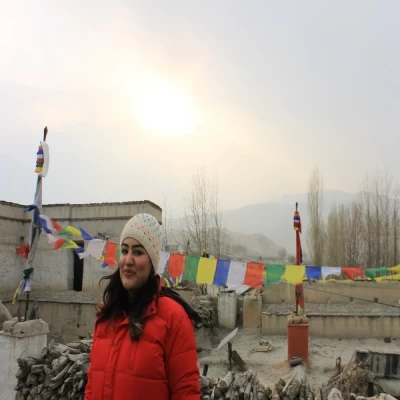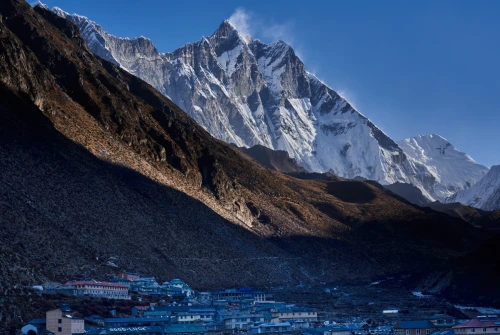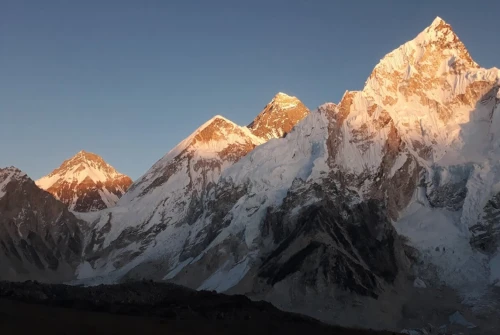Trekking to Everest Base Camp is one of the most iconic and rewarding hiking adventures on Earth. But success on this high-altitude trail depends heavily on when you go. In this comprehensive guide, we explain the best time for the Everest Base Camp trek, analyzing every season and every month, so you can make the most informed decision and enjoy a safe, scenic, and satisfying journey.
The Everest region experiences four distinct trekking seasons throughout the year. These include Spring (March to May), Monsoon/Summer (June to August), Autumn (September to November), and Winter (December to February). Each of these seasons brings its own set of weather conditions, crowd levels, and trail characteristics. Knowing what each season offers helps you align your personal goals—whether it’s capturing clear mountain views, avoiding crowds, or enjoying a quieter, off-peak trek.
Spring (March to May): Ideal Weather and Blooming Rhododendrons
Spring is considered one of the most favorable times to embark on the Everest Base Camp trek. This season marks the end of winter, and the mountains gradually warm up with longer days and increased sunlight. The trails come alive with blooming rhododendrons, making the trek visually stunning. Moreover, stable weather and clear skies dominate this period, allowing trekkers to fully absorb the breathtaking views of Everest, Lhotse, Nuptse, and Ama Dablam.
March
March is the beginning of the trekking season in the Everest region. While some traces of winter snow may still be present on the trails, the weather starts to warm up, especially during the day. It's slightly warm with a range of -12°C to 0°C. This month is perfect for those who prefer fewer crowds and want to enjoy snow-capped scenery without the intense cold of deep winter. However, temperatures can still drop significantly at night, so adequate layering is essential.
Daytime Temperature: -2°C to 5°C
Nighttime Temperature: -12°C to -8°C
April
April is one of the best months in the spring season for the EBC Trekking. It is more pleasant, spanning 5°C to 10°C. The days are warmer, and the weather is generally very stable with clear blue skies. Rhododendrons are in full bloom, adding a splash of color to the trails. This is also the time when Everest climbing expeditions start to set up base camp, adding an extra layer of excitement to the experience. Due to its ideal conditions, April is also one of the most crowded months, so booking in advance is advisable.
Daytime Temperature: 8°C to 12°C
Nighttime Temperature: -6°C to 0°C
May
May marks the tail end of the spring season and is characterized by even warmer temperatures. It offers milder trekking weather, from 0°C to 15°C. The trails remain lush and lively, and mountain views continue to impress, especially in the early half of the month. However, as the month progresses, humidity starts to rise, and clouds from the approaching monsoon may occasionally obscure the views. Still, May is a solid option for those seeking a quieter experience than April, with only a slight trade-off in visibility.
Daytime Temperature: 10°C to 15°C
Nighttime Temperature: -5°C to 0°C
Summer/Monsoon (June to August): For the Brave and Solitary
The summer months coincide with the monsoon season in Nepal. During this time, the Everest region experiences heavy rainfall, especially at lower elevations. Trekkers who venture into the region during this time often do so for solitude rather than scenery. While lush green landscapes and vibrant flora make the trails beautiful in their way, visibility of mountain peaks is often compromised, and trail conditions can be slippery and treacherous.
June
June marks the start of the monsoon. While early June may still offer some clear days, the rainfall quickly becomes consistent. June kicks off the monsoon with 2°C to 16°C, temperatures are relatively warm, making it physically easier to trek. However, the downside is muddy trails, occasional leeches, and the potential for landslides, especially between Lukla and Namche Bazaar. Flights to and from Lukla are frequently delayed or canceled due to poor weather.
Daytime Temperature: 12°C to 18°C
Nighttime Temperature: 2°C to 6°C
July
July is generally the wettest month in the Everest region. Rainfall is frequent and heavy, and the trails are at their most slippery. July stays humid and rainy between 4°C and 18°C. The upside is complete solitude; very few trekkers attempt the EBC trail during this time. Lush vegetation and powerful waterfalls are in abundance, creating a very different, almost mystical trekking environment. But those considering this period must be prepared for delayed logistics and reduced mountain views.
Daytime Temperature: 14°C to 19°C
Nighttime Temperature: 4°C to 8°C
August
August continues the monsoon trend but starts to see a slow decline in rainfall, particularly toward the end of the month. It remains similar to July, with temperatures ranging from 5°C to 17°C. The trails remain quiet, and accommodations are readily available. While the mountain views are still largely obscured by clouds, glimpses of the peaks can occasionally be seen, especially early in the morning. This month is better suited for trekkers who don’t mind getting wet and value peaceful surroundings over clear vistas.
Daytime Temperature: 13°C to 17°C
Nighttime Temperature: 5°C to 9°C
Autumn (September to November): The Golden Season for Trekking
Autumn is the most popular season for the Everest Base Camp trek and for good reason. Following the monsoon, the skies clear up, the air is crisp, and the landscape is washed clean. This season offers the most reliable weather, excellent visibility, and some of the most comfortable trekking temperatures.
September
September begins with residual monsoon effects, including some lingering rainfall and cloudy skies. However, as the month progresses, the weather stabilizes and the clouds give way to sunshine and panoramic views. The temperature cools again to 0°C to 14°C, offering clearer The trails start to fill with trekkers, but it’s not yet as crowded as in October. September is perfect for those who want to enjoy autumn conditions with a bit more breathing room.
Daytime Temperature: 10°C to 14°C
Nighttime Temperature: 0°C to 4°C
October
October is the most sought-after month for the Everest Base Camp trek. It boasts clear skies, cool temperatures, and dazzling views of the Himalayan peaks. is ideal for trekking, with temperatures between -6°C and 12°C. The weather is extremely stable, which means fewer chances of flight cancellations or weather-related disruptions. Cultural highlights such as the Mani Rimdu festival add an extra layer of interest to treks during this month. However, due to its popularity, October is also the busiest month on the trail, and early booking is essential.
Daytime Temperature: 8°C to 12°C
Nighttime Temperature: -6°C to -2°C
November
November retains the excellent visibility of October while temperatures begin to drop, especially at night. November brings the chill, ranging from -10°C to 5°C. With fewer trekkers on the trail compared to October, this month offers a quieter experience while still delivering stunning views and favorable trekking conditions. As the month progresses, prepare for colder nights and early snowfall at higher altitudes.
Daytime Temperature: 5°C to 10°C
Nighttime Temperature: -10°C to -5°C
Winter (December to February): Quiet Trails and Snowy Landscapes
Winter is the coldest time to trek to Everest Base Camp. The region becomes quieter as fewer trekkers venture into the cold. However, for those who are well-prepared and willing to brave the freezing temperatures, the rewards include peaceful trails and some of the clearest mountain views available all year.
December
December is the most accessible winter month for trekking. The skies are generally clear, and snowfall is minimal in early December. It returns to deep winter cold, with temperatures from -15°C to -5°C. You can enjoy beautiful views with minimal foot traffic. However, the temperatures drop sharply, especially at night, so it’s essential to have the right cold-weather gear. Some tea houses may start closing toward the end of the month.
Daytime Temperature: -2°C to 4°C
Nighttime Temperature: -15°C to -8°C
January
January is the coldest month in the Everest region. In January, expect extreme cold ranging from -20°C to -10°C. Temperatures can plummet well below freezing even during the day, and high mountain passes may be closed due to snow. That said, the crisp winter air makes for incredibly sharp visibility. Trekkers who choose this month often do so for solitude and the surreal beauty of the snow-covered Himalayas.
Daytime Temperature: -6°C to -3°C
Nighttime Temperature: -20°C to -12°C
February
February signals the slow transition from winter to spring. It is also freezing between -18°C and -8°C. Days become slightly warmer, although nights remain very cold. The trails are still quiet, making it an attractive option for those who prefer a peaceful experience. Some lower-altitude wildflowers begin to bloom, hinting at the spring season ahead.
Daytime Temperature: -3°C to 3°C
Nighttime Temperature: -18°C to -10°C
Everest Base Camp Trek Season Comparison Table
Feature | Spring (March–May) | Autumn (September–November) | Winter (December–February) |
Overall Rating | Excellent | Outstanding | Moderate |
Weather Conditions | Mild days, cold nights; stable climate | Crisp days, cold nights; very stable | Cold to freezing temperatures; snow possible |
Mountain Views | Excellent – snow peaks and blooming valleys | Breathtaking – sharp, panoramic views | Beautiful – snow-covered scenery |
Trail Conditions | Dry and firm, occasional snow patches | Dry, clean, and best maintained | Snowy and icy in higher sections |
Crowd Levels | Medium to High | Very High in October, Moderate in November | Low to Very Low |
Accommodation Access | Fully open; high demand in April | Fully open; booking required | Some teahouses may be closed |
Special Highlights | Rhododendron blooms, climbing expeditions | Cultural festivals (e.g., Mani Rimdu), green post-monsoon trails | Silent, tranquil trails; snow trekking experience |
Recommended For | First-timers, photographers, and nature lovers | All trekkers; ideal for the best views and weather | Experienced trekkers, solitude seekers, snow lovers |
Best Month | April | October | December |
This seasonal breakdown gives a quick yet comprehensive reference to help trekkers decide the best time to embark on the Everest Base Camp trek, based on their preferences, fitness level, and goals
Final Recommendations for Choosing the Best Time
Choosing the ideal time to trek to Everest Base Camp Trek depends on what kind of experience you're seeking. For most trekkers, especially first-timers, October and May stand out as the top months due to their clear weather, safe trails, and spectacular mountain views. October, in the autumn season, offers dry weather, stable temperatures, and excellent visibility. The monsoon has just cleared the air, giving you panoramic views of snow-capped Himalayan peaks. It's also a festive season in Nepal, with local culture adding charm to the journey.
May, during spring, welcomes trekkers with warmer days and blooming rhododendrons, painting the trails with vibrant colors. The skies remain clear, and temperatures are comfortable, creating ideal conditions for photography and altitude adjustment.
For those looking to avoid the crowds and prefer solitude, December and February provide a quieter atmosphere, though they come with freezing temperatures and more challenging conditions. Meanwhile, late May and September serve as shoulder months, offering a good balance of moderate weather, fewer trekkers, and sometimes lower costs.
Ultimately, whether you prioritize weather, solitude, cost, or scenery, there’s a season that fits your goals. But if you're aiming for the most well-rounded and picturesque trekking experience, October and May are undeniably the best choices.
Bonus Tip: Book Early and Prepare Well
No matter which month you choose, it’s critical to book your flights to Lukla, accommodations, and guides well in advance, especially during peak seasons. Always prepare with layered clothing, quality footwear, and altitude sickness precautions. Mountain weather is unpredictable, so flexibility is key to a successful trek.




